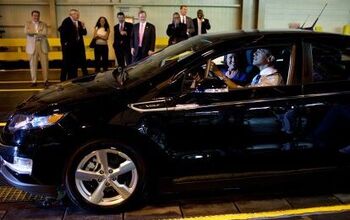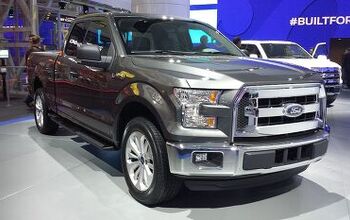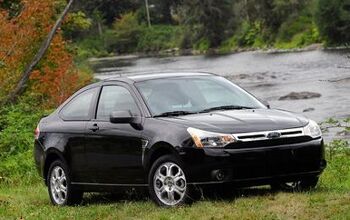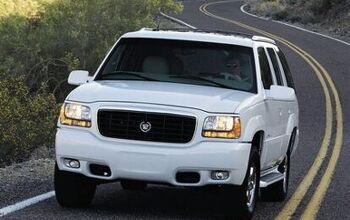The Truth About Car Advertising
On second thought, look for yourself. Most automobile commercials include a small disclaimer like “closed course,” “professional driver,” “do not attempt” or some other CYA statement mandated by the company’s legal department. It’s there to protect them against ambulance chasers waiting for a buyer to injure themselves or (preferably) die when they try to make their vehicle do what it did in the commercial– even if that’s just driving around a corner. You have to wonder about a world where companies showcase an SUV driving off-road, or a sports car zooming through a road course, then feel obliged to tell the buyer “do not attempt” to do the same. Just what are we supposed to do with these vehicles?
The TV commercials for the new Mercedes GL-class are probably the best/worst example. The ads show the Alabama-built off-roader shrugging off the impact of a crash test sled, towing more than a Peterbilt can handle, hauling an entire vacation home full of stuff and tackling a slalom course so fast it sets the cones on fire (actually my first impression was the brakes were overheating so badly they ignited the cones). All this wouldn’t be too bad if it was presented Joe Isuzu-style, with humorous disclaimers. Instead, the word “fictionalization” appears in letters small enough to qualify as a DMV eye test, flashing by so fast it could serve as an Evelyn Wood final exam.
Autodisclaimermania reminds of a five-year old who lies about breaking a lamp but thinks it’s OK (and he won’t be caught) because his fingers were crossed. When it comes to portraying extreme performance capabilities that might not actually be, you know, possible, or, equally worrying, destroying the vehicle involved in the display, truck ads are particularly notable offenders. Could someone explain what “underbody digitally modified” meant in the Ford truck ad showing an F-150 crushed between two bulldozers? Did the frame crumple like a beer can against a frat boy’s forehead? Why won’t they show us what really happened? Or tell us they actually crushed four trucks to make that commercial?
Then there’s a special category of ads operating so far outside the realm of reality they should be classified as novelization. These ads try to sell us on a vehicle’s ability to cater to/create a particular “lifestyle,” or seek to fill us with warm fuzzies (WF) for a company building vehicles that can’t stand evaluation on their own or relative merits. Here’s a simple question: how many Americans actually own a kayak? How many go rock climbing? Not as many as own SUV’s. But that doesn’t stop their manufacturers from selling their lumbering land yachts as gateways to the great outdoors. Nissan may urge potential owners to “tell better stories,” but it would be hard come up with more imaginative fiction that their lifestyle vignettes.
The poster child for the WF concept is Ford’s “Bold Moves” campaign. The Coca-Cola style ads show a quick cut montage of bold Americans doing courageous and noble things– from a teenager getting his first driver's license to a woman with breast cancer entering the Susan G. Komen Breast Cancer Foundation's Race for the Cure. So… where are the cars? They don’t appear until the ad’s closing seconds. What does that tell us about Ford vehicles? Either a great deal (Ford’s ethics, spirit and community service) or nothing (), depending on whether or not you got paid to throw around words like “target demographic.”
Of course, Ford’s not the only one inviting customers to share their highly selective alternate reality. Toyota touts their “hybrid synergy” but neglects to mention its profitable flotilla of gas-guzzling Tundras and Sequoias. GM brags how many of its cars get better than 30 MPG in highway driving, but fails to disclose that their whips are a lot less efficient around town, and that their overall fleet hews closely to the Corporate Average Fuel Economy legislation. (Unlike BMW.)
You have to wonder who the car makers and their advertising lackeys think they’re fooling. They aren’t fooling me and I doubt they’re fooling you. The truth is they, like Joe Isuzu, they are only fooling themselves. And if I’m lying, may lightning strike my computer.
More by Frank Williams
Latest Car Reviews
Read moreLatest Product Reviews
Read moreRecent Comments
- Turbo Is Black Magic My wife had one of these back in 06, did a ton of work to it… supercharger, full exhaust, full suspension.. it was a blast to drive even though it was still hilariously slow. Great for drive in nights, open the hatch fold the seats flat and just relax.Also this thing is a great example of how far we have come in crash safety even since just 2005… go look at these old crash tests now and I cringe at what a modern electric tank would do to this thing.
- MaintenanceCosts Whenever the topic of the xB comes up…Me: "The style is fun. The combination of the box shape and the aggressive detailing is very JDM."Wife: "Those are ghetto."Me: "They're smaller than a Corolla outside and have the space of a RAV4 inside."Wife: "Those are ghetto."Me: "They're kind of fun to drive with a stick."Wife: "Those are ghetto."It's one of a few cars (including its fellow box, the Ford Flex) on which we will just never see eye to eye.
- Oberkanone The alternative is a more expensive SUV. Yes, it will be missed.
- Ajla I did like this one.
- Zerofoo No, I won't miss this Chevrolet Malibu. It's a completely forgettable car. Who in their right mind would choose this over a V8 powered charger at the rental counter? Even the V6 charger is a far better drive.


































Comments
Join the conversation
I think the ads that skirt the truth, like showing SUVs climbing mountains and taking people kayaking (or, for that matter, guys drinking Budweiser and getting chatted up by beautiful women) are within the bounds of truthiness, and if you're fooled by that it's your own damn fault. But that ad with the F-150 and the bulldozers sure fooled me. I have no interest in trucks, but my reaction was "wow that looks pretty good!" I'm not sure how exactly a legal distinction can be made, but that looks like straight-up lying to me.
The ALLDERBLOB came across this post as hit number 50 or so in a google search of the phrase "full car advertising." We didn't know what "full car advertising" meant, or where it would lead, but when you google it (without the quotes) you get a hell of a lot of hits. Fact is, according to our site stats, it's a phrase that led someone to us, and we're always interested in how that happens. But to tell the truth, we never found the link to our site from within those 80,600,000 google hits. What stopped us was your promising title. "The Truth about Car Advertising" is a pretty potent come-on, as you gotta realize. It's actually a brilliant and complex phrase, an oxymoron or something--you know, a phrase that contains within it a contradiction or a denial of its central premise. But in reading your editorial we realized you have not realized the full promise of the title you chose. It's as if you did not grasp the cognitive dissonance brought on by placing the words "truth" and "car advertising" in such close proximity. Or maybe it's just that The ALLDERBLOB takes a different position on car ads than your editorial does. We think car ads tell lies by definition, and their central lie is so pernicious, so destructive to society at large, so, well, evil, that there is no alternative in a society that wishes to defend itself and protect its future prosperity but to ban them outright.